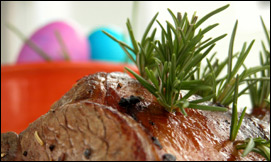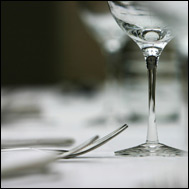Easter food feasts, without chocolate eggs
Feature
Before Cadbury and Nestle kidnapped Easter and turned the holiday into a chocolate egg binge, the UK traditionally celebrated with roasted lamb dishes and colourful, painted eggs - of the chicken variety. In other cultures, Easter celebrations revolve around breakfast feasts; others wait until later in the day.
If you are off chocolate this Easter but want to mark the day with a feast, dishes from Sweden, Greece and Eastern Europe uphold a truer tradition of Easter.
Most of the Easter celebrations in Sweden take place during the Holy Week before Easter Sunday. On Easter Saturday, little girls dress up as Easter hags, wearing witch costumes and travelling from door-to-door handing out handmade pictures in exchange for sweets, just like Halloween. This tradition stems from an old Swedish folklore that believed witches were most powerful and destructive during the Holy Week.
By Easter Sunday, the little Easter hags and their parents are ready for a large breakfast of eggs, breads, sweets and coffee.
For the main meal of the day, the feast consists of herrings, often sild (raw herrings in a spicy sauce made from vinegar and onions). There are boiled eggs, fish dishes or roast ham, often served with a dish called Jansson’s Temptation, made of sliced potatoes baked with anchovies and cream. Beer and schnapps, along with cheese, white rye and crisp bread form the most popular meal accompaniments.
The Greeks believe in breaking the fast with a large dinner full of traditional foods. Before the big meal, however, the Greek people have a solemn week of religious processions and regular attendance at mass. One pre-Easter Sunday tradition takes place on Maundy Thursday and includes dying eggs a deep red colour. During Saturday’s mass, the red eggs are cracked and opened to recount the miracle of Christ’s rebirth and resurrection.
After Easter Saturday’s midnight mass, fasting Greeks will break lent with an Easter soup called mageiritsa. This is made with lambs’ innards, rice, cos lettuce, wild fennel, spring onions and avgolemono (egg and lemon sauce).
On Easter Sunday, the feast begins around noon and often stretches on through the afternoon and well into evening. The festivities are celebrated with a traditional roast dinner of lamb or goat. Other Easter dishes include an Easter torte filled with seasonal cheeses, lamb and cinnamon. You may not wish to indulge in some of the stranger dishes. One of these is an offal dish called kokoretsi, which is spit-roasted lambs’ innards wrapped in intestines.
Easter is the most important festival throughout Eastern Europe, and food preparations begin the week before Easter, known as Passion Week, where an enormous range of pastries, cakes and biscuits are prepared.
Eastern Europeans break their fast by sharing a blessed egg, which is cut into small pieces and eaten in solemn silence. This is followed by a feast of ham, roast veal, suckling pig, boiled pork, roast turkey or goose. There are sausages, pancakes, stuffed cabbage, hrudka (a strange sweet Easter ‘cheese’ made from eggs), decorated coloured eggs, and krupnik (honey vodka). 

Mr Wing
Book Indian Restaurants
Little India
Khan's of Kensington
Shezan Restaurant
Book Italian Restaurants
Montpeliano
Sopranos
Brunello Restaurant
Book Modern & European Restaurants
Park Terrace Restaurant
L Restaurant and Bar
The Terrace
Book Thai Restaurants
Blue Lagoon Thai Restaurant
Thai Origin
Restaurant Reader Reviews
Cafe News Bar Asia
Chelsea Lounge
Greek Affair
Harvest Brasserie
Pizza@Home
Rice Restaurant
Feng Sushi: Kensington Church Street
Jacobs
Lorenzos
The Orangery
Food News & Features
Farmers' Markets
Star grazing
Taste festivals 2007
Healthy Eating
Sizzling and safe summer eating
Why fast needn't mean fattening
A nation of unhealthy takeaway addicts
Wine & Drinks
The white choice
Get to grips with grapes
Tea Boom
Celebrity Chefs
Gordon Ramsay
Jamie Oliver
Marco Pierre White




